
The 3rd International Electronic Conference on Materials
Part of the International Online Conference on Materials series
14–28 May 2018
materials characterization, Nanotechnology, Manufacturing
- Go to the Sessions
- Event Details
Welcome from the Chairs
I am pleased to welcome you to the 3rd International Electronic Conference on Materials (ECM-3). The first and second editions of this conference held in 2014 and 2016 respectively, were a great success that encouraged the organizing committee to continue this tradition by launching the 3rd edition of this event from May 14 to 28 in 2018. Throughout this event, we aim to cover the following topics:
- Topic A: Materials Characterization
- Topic B: Nanotechnology in Material sciences and Engineering
- Topic C: Manufacturing Processes and Systems
- Topic D: Biomaterials
- Topic E: Fibers and Membrans
- Topic F: Optical, Electrical and Magnetic Materials
This is a virtual conference held at www.sciforum.net/conference/ecm-2018. Sciforum.net is the platform developed by MDPI and sponsored by the Open Access Journal Materials to organize electronic conferences, and to provide our community with the technical support for hosting our digital events. This platform is set in response to the high demand from our community whom might not have always required material and human resources for travelling and participating physically in high quality scientific events.
ECM-3 provides the participants with the unique opportunity to disseminate among their peers, in an open forum, their knowledge and latest research finding in materials field and receive immediately rich feedback from the virtual audience towards their future research directions.
The participation is free of charge – both for authors and attendees. Accepted papers will be gathered in the proceedings of the conference, and selected papers will be published in Materials through invitation from the Editor-in-Chief of Materials.
I am very enthusiastic about this third addition of e-conference in Materials and am relying of you to make it a successful event again.
Chair of the 3rd International Electronic Conference on Materials

Professor of Biomedical Engineering
Associate Dean-Research and Graduate Studies-Faculty of Dentistry
Chair of the 3rd International Electronic Conference on Materials
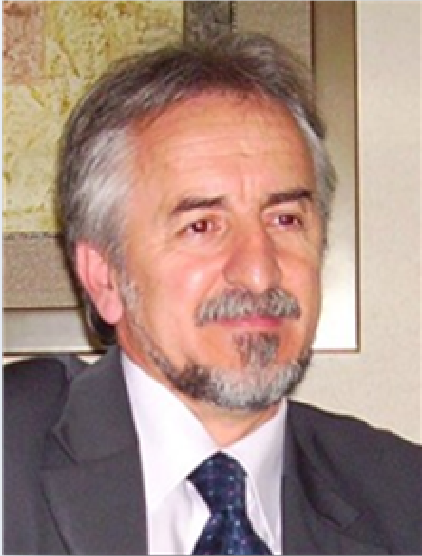
Director of ARC Graphene Research Hub
Leader Nano Research Group
School of Chemical Engineering
The University of Adelaide, Australia
dusan.losic@adelaide.edu.au
Conference Chair
Professor Maryam Tabrizian
Maryam Tabrizian is professor in the Biomedical Engineering Department and the Faculty of Dentistry at McGill University. She was FRSQ-Chercheure nationale awardee (2006-2011), elected as fellow of Royal Society of Canada in 2017, became Guggenheim Fellow in Biomedical Sciences in 2010 and the Fellow of the Biomaterials Science & Engineering (FBSE) in 2011 for her contribution to the field of Biomedical Engineering and Biomedical Sciences. She received her PhD degree in Physical Sciences with a multidisciplinary background including physics, chemistry and biology from Université Pierre et Marie Curie-École Supérieure de Physique et de Chimie de Paris in 1990. She was the director of the Centre for Biorecognition and Biosensors (CBB) for 10 years that she has founded in 2001. She is internationally known for her work in the in design of functional and bioactive biointerface as well as advanced biomaterials for their application in nanomedicine and regenerative medicine as well as for Lab-on a Chip devices. She is the author of more than 170 peer-reviewed papers in her field of expertise, over 95 invited lectures, many book chapters, patents, and over 350 scientific communications and outreach activities. She is currently the Editor-in-Chief of Journal of Materials, Associate Editor of the Journal of Biological Engineering (JBI), and the International Journal of Biomaterials Research and Engineering (IJBRE).
Professor Dusan Losic
Prof Dusan Losic, is a Research Professor in School of Chemical Engineering, The University of Adelaide, Australia working as Leader of Nano Research group of 20 researchers and Director of ARC Research Hub for Graphene Enabled Industry Transformation, involving 4 University and 7 Industry partners, and > 40 researchers. He completed PhD (Nanoscience and Nanotechnology) in 2003 at Flinders University, School of Chemical and Physical Science, Adelaide, where he spent 3 year working as a Research Fellow followed by 5 years as ARC Research Fellow at University of South Australia and from 2012 as ARC Future Fellow at the University of Adelaide. His multidisciplinary research involves fundamental, engineering and applied aspects across several disciplines focused one engineering, and applications of nanoscale materials to address concerning environmental, health, energy, agriculture and security problems. His research outcomes include published >250 journal (>8000 citations, H-index >45, 15 journal covers), >60 conference papers, >150 conference presentations, 7 patents, 4 licensed technology, attracting more >$20M research funding, including $7M from industry successfully completing >20 industry projects.
Call for Papers
The 3rd International Electronic Conference on Materials Science (ECMS 2018) will be held from 14 to 28 May 2018. All proceedings will be held online at https://sciforum.net/conference/ecms2018.
Throughout this event, we aim to cover the following topics:
- Topic A: Materials Characterization
- Topic B: Nanotechnology in Material sciences and Engineering
- Topic C: Manufacturing Processes and Systems
- Topic D: Biomaterials
- Topic E: Fibers and Membranes
- Topic F: Optical, Electrical and Magnetic Materials
The conference will be completely free of charge—both to attend, and for scholars to upload and present their latest work on the conference platform. There will be a possibility to submit selected papers to the journal Materials (ISSN 1996-1944; 2.654 (2016); https://www.mdpi.com/journal/materials), with a 10% discount on the APCs; ECMS 2018 offers you the opportunity to participate in this international, scholarly conference without having the concern or expenditure of travel — all you need is your computer and access to the Internet.
This year, as a sponsor, Materials would like to award the best paper as elected by the conference committee. The Award will consist of 500 Swiss Francs. We would like to invite you to “attend” this conference by presenting your latest work.
Abstracts (in English) should be submitted by 06 Feb. 2018 online at https://www.sciforum.net/login. For accepted abstracts, the full paper can be submitted by 14 Apr. 2018. The conference itself will be held 14–28 May 2018.
Paper Submission Guidelines
For information about the procedure for submission, peer-review, revision and acceptance of conference proceedings papers, please refer to the section "Instructions for Authors" https://sciforum.net/conference/ecms2018/instructions.
Conference Chairs

Editor-in-Chief of the Journal Materials
Professor of Biomedical Engineering
Associate Dean-Research and Graduate Studies-Faculty of Dentistry
Fellow of Royal Society of Canada-Academy of Science
Guggenheim Fellow in Biomedical Sciences
Maryam Tabrizian is professor in the Biomedical Engineering Department and the Faculty of Dentistry at McGill University. She was FRSQ-Chercheure nationale awardee (2006-2011), elected as fellow of Royal Society of Canada in 2017, became Guggenheim Fellow in Biomedical Sciences in 2010 and the Fellow of the Biomaterials Science & Engineering (FBSE) in 2011 for her contribution to the field of Biomedical Engineering and Biomedical Sciences. She received her PhD degree in Physical Sciences with a
maryam.tabrizian@mcgill.ca

Chair of the 3rd International Electronic Conference on Materials
Editor Board Member of the Journal Materials
Director of ARC Graphene Research Hub
Leader Nano Research Group
School of Chemical Engineering
The University of Adelaide, Australia
Prof Dusan Losic, is a Research Professor in School of Chemical Engineering, The University of Adelaide, Australia working as Leader of Nano Research group of 20 researchers and Director of ARC Research Hub for Graphene Enabled Industry Transformation, involving 4 University and 7 Industry partners, and > 40 researchers. He completed PhD (Nanoscience and Nanotechnology) in 2003 at Flinders University, School of Chemical and Physical Science, Adelaide, where he spent 3 year working as a Research
dusan.losic@adelaide.edu.au
Conference Committee
Department of Engineering, University of Naples Parthenope, Naples, Italy
colangelo@uniparthenope.it
Instructions for Authors
Submission
Submissions should be done by the authors online by registering with www.sciforum.net, and using the "New Submission" function once logged into system.
- Scholars interested in participating with the conference can submit their abstract (about 150-300 words covering the areas of manuscripts for the proceedings issue) online on this website until 06 Feb. 2018.
- The Conference Committee will pre-evaluate, based on the submitted abstract, whether a contribution from the authors of the abstract will be welcome for the ECMS 2018. All authors will be notified by 27 Feb. 2018 about the acceptance of their abstract.
- If the abstract is accepted for this conference, the author is asked to submit his/her manuscript, optionally along with a PowerPoint (only PDF) and/or video presentation of his/her paper, until the submission deadline of 14 Apr. 2018.
- The manuscripts and presentations will be available on https://sciforum.net/conference/ecms2018 for discussion and rating during the time of the conference 14-28 May. 2018.
- The Open Access Journals Materials will publish Special Issue of the conference and accepted papers will be published in the proceedings of the conference. After the conference, the Conference Committee will select manuscripts that may be included for publication in this Special Issue of journal Materials. (please note: the submission to the journal is independent from the conference proceedings and will follow the usual process of the journal, including peer-review, APC...; The conference proceedings will be included in a single issue of Proceedings journal (ISSN 2504-3900) after conference. Proceedings is an open access journal published by MDPI, dedicated to publishing all kinds of outputs from academic conferences.).
Manuscripts for the proceedings issue must have the following organization:
- Title
- Full author names
- Affiliations (including full postal address) and authors' e-mail addresses
- Abstract
- Keywords
- Introduction
- Methods
- Results and Discussion
- Conclusions
- (Acknowledgements)
- References
Manuscripts should be prepared in MS Word or any other word processor and should be converted to the PDF format before submission. The publication format will be PDF. The manuscript should count at least 3 pages (incl. figures, tables and references). There is no page limit on the length, although authors are asked to keep their papers as concise as possible.
Authors are encouraged to prepare a presentation in PowerPoint or similar software, to be displayed online along with the Manuscript. Slides, if available, will be displayed directly in the website using Sciforum.net's proprietary slides viewer. Slides can be prepared in exactly the same way as for any traditional conference where research results can be presented. Slides should be converted to the PDF format before submission so that our process can easily and automatically convert them for online displaying.
Besides their active participation within the forum, authors are also encouraged to submit video presentations. If you are interested in submitting, please contact the conference organizer at ecms2018@mdpi.com to get to know more about the procedure. This is an unique way of presenting your paper and discuss it with peers from all over the world. Make a difference and join us for this project!
Authors that wish to present a poster only, i.e. without proceedings paper, can do so in section G. - Posters of this conference. Posters will be available on this conference website during and after the event. Like papers presented on the conference, participants will be able to ask questions and make comments about the posters. Posters that are submitted without paper will not be included in the proceedings of the conference.
Submission: Manuscripts should be submitted online at www.sciforum.net/login by registering and logging in to this website.
Accepted File Formats
- MS Word: Manuscript prepared in MS Word must be converted into a single file before submission. When preparing manuscripts in MS Word, the Electronic Conference on Materials Science Microsoft Word template file (see download below) must be used. Please do not insert any graphics (schemes, figures, etc.) into a movable frame which can superimpose the text and make the layout very difficult.
- Electronic Conference on Materials Science MS Word Template File
- References: References must be numbered in order of appearance in the text (including tables and legends) and listed individually at the end of the manuscript. We recommend preparing the references with a bibliography software package, such as EndNote, ReferenceManager or Zotero to avoid typing mistakes and duplicated references. Citations and References in Supplementary files are permitted provided that they also appear in the main text and in the reference list. In the text, reference numbers should be placed in square brackets [ ], and placed before the punctuation; for example [1], [1–3] or [1,3]. For embedded citations in the text with pagination, use both parentheses and brackets to indicate the reference number and page numbers; for example [5] (p. 10). or [6] (pp. 101–105). The Reference list should include the full title as recommended by the ACS style guide. The style file for endnote, MDPI.ens, can be found at https://endnote.com/downloads/style/mdpi
- Author List and Affiliations: Authors' full first and last names must be provided. The initials of any middle names can be added. The PubMed/MEDLINE standard format is used for affiliations: complete address information including city, zip code, state/province, country, and all email addresses. At least one author should be designated as corresponding author, and his or her email address and other details should be included at the end of the affiliation section. Please read the criteria to qualify for authorship.
- Figures, Schemes and Tables: All figure files should be separately uploaded during submission. Figures and schemes must be provided at a sufficiently high resolution (minimum 1000 pixels width/height, or a resolution of 300 dpi or higher). All Figure file formats are accepted. However, TIFF, JPEG, EPS and PDF files are preferred. Materials can publish multimedia files in articles or as supplementary materials. Please get in touch with the Editorial office for further information. All Figures, Schemes and Tables should also be inserted into the main text close to their first citation and must be numbered following their number of appearance (Figure 1, Scheme I, Figure 2, Scheme II, Table 1, etc.). All Figures, Schemes and Tables should have a short explanatory title and a caption. All table columns should have an explanatory heading. To facilitate the copy-editing of larger tables, smaller fonts may be used, but in no less than 8 pt. in size. Authors should use the Table option of Microsoft Word to create tables. For multi-panel figures, the file must contain all data in one file. For tips on creating multi-panel figures, please read the helpful advice provided by L2 Molecule. Authors are encouraged to prepare figures and schemes in color (RGB at 8-bit per channel). Full color graphics will be published free of charge.
For further enquiries please contact us at ecms2018@mdpi.com.
Authors wishing to publish their papers are asked to abide to the following rules:
- Any facts that might be perceived as a possible conflict of interest of the author(s) must be disclosed in the paper prior to submission.
- Authors should accurately present their research findings and include an objective discussion of the significance of their findings.
- Data and methods used in the research need to be presented in sufficient detail in the paper, so that other researchers can replicate the work.
- Raw data should preferably be publicly deposited by the authors before submission of their manuscript. Authors need to at least have the raw data readily available for presentation to the referees and the editors of the journal, if requested. Authors need to ensure appropriate measures are taken so that raw data is retained in full for a reasonable time after publication.
- Simultaneous submission of manuscripts to more than one journal is not tolerated.
- Republishing content that is not novel is not tolerated (for example, an English translation of a paper that is already published in another language will not be accepted).
- If errors and inaccuracies are found by the authors after publication of their paper, they need to be promptly communicated to the editors of this journal so that appropriate actions can be taken. Please refer to our policy regarding publication of publishing addenda and corrections.
- Your manuscript should not contain any information that has already been published. If you include already published figures or images, please obtain the necessary permission from the copyright holder to publish under the CC-BY license.
- Plagiarism, data fabrication and image manipulation are not tolerated.
MDPI AG, the publisher of the Sciforum.net platform, is an open access publisher. We believe that authors should retain the copyright to their scholarly works. Hence, by submitting a Communication paper to this conference, you retain the copyright of your paper, but you grant MDPI AG the non-exclusive right to publish this paper online on the Sciforum.net platform. This means you can easily submit your paper to any scientific journal at a later stage and transfer the copyright to its publisher (if required by that publisher).
List of accepted submissions (14)
| Id | Title | Authors | Poster PDF | ||||||||||||||||||||||||||||||||||||||
|---|---|---|---|---|---|---|---|---|---|---|---|---|---|---|---|---|---|---|---|---|---|---|---|---|---|---|---|---|---|---|---|---|---|---|---|---|---|---|---|---|---|
| sciforum-016854 | Preparation and Identification of CuCr2O4 Nanoparticles and Investigation of its Microwave Absorption Characteristics at x-band Frequency using Silicone Rubber Polymeric Matrix | , | N/A |
Show Abstract |
|||||||||||||||||||||||||||||||||||||
|
Lately, silicone rubber because of the desirable permittivity on the one hand and various applications in the implants, membranes, Solar cells, sensors, Semiconductor devices, high frequency devices, photothermal therapy methods, acoustic metamaterials, and insulator materials on the other hand has attracted considerable attentions. In this research, CuCr2O4 nanoparticles were prepared according to the sol-gel method and then were identified by Fourier transform infrared (FT-IR), X-ray powder diffraction (XRD), field emission scanning electron microscopy (FE-SEM), and vibrating sample magnetometer (VSM). Results showed that monophase crystal structure with identical morphology of CuCr2O4 nanoparticles has been synthesized. Finally, CuCr2O4 nanoparticles and silicone rubber were composited and then microwave absorbing properties of the CuCr2O4/silicone rubber nanocomposite were investigated by vector network analyzer (VNA) exhibiting 48.56 dB microwave attenuation of the CuCr2O4/silicone rubber nanocomposite with 2.6 mm thickness at 10.9 GHz frequency and more than 92.99% microwave absorption in the x-band frequency. |
|||||||||||||||||||||||||||||||||||||||||
| sciforum-016853 | Preparation and Characterization of CuFe2O4 Nanoparticles by the Sol-Gel Method and Investigation of its Microwave Absorption Properties at Ku-band Frequency using Silicone Rubber | , , | N/A |
Show Abstract |
|||||||||||||||||||||||||||||||||||||
|
Recently, using microwave devices emitting electromagnetic waves due to enhancing convenient life have been increased that can be harmful to the environment. In this study, CuFe2O4 nanoparticles were prepared through the conventional sol-gel procedure and then were characterized by X-ray powder diffraction (XRD), vibrating sample magnetometer (VSM), field emission scanning electron microscopy (FE-SEM), Fourier transform infrared (FT-IR), and vector network analyzer (VNA) using S parameters. Results illustrated that pure crystal structure of magnetic nanoparticles has been synthesized by the sol-gel method with 26.91 emu/g magnetic saturation (Ms). Finally, CuFe2O4 nanoparticles were composited by silicone rubber to investigate of its microwave absorption properties. Results showed that CuFe2O4/silicone rubber nanocomposite absorbed more than 94.87% of microwave at ku-band frequency with 1.7 mm thickness and the maximum reflection loss was -60.38 dB at 16.1 GHz. Magnetic and dielectric properties of the CuFe2O4 nanoparticles and silicone rubber polymeric matrix in the nanocomposite demonstrated desirable microwave absorption properties. |
|||||||||||||||||||||||||||||||||||||||||
| sciforum-018189 | Reliability of Orthodontic Miniscrews: Bending and Maximum Load of Different Ti-6Al-4V Titanium and Stainless Steel Temporary Anchorage Devices (TADs). | , , , , |

|
Show Abstract |
|||||||||||||||||||||||||||||||||||||
|
Temporary anchorage devices (TADs) have been introduced in orthodontic clinical practice in order to allow tooth movements avoiding side effects in the position of adjacent teeth. Miniscrews are available on the market with different diameters and materials. Accordingly, the purpose of the present report was to measure and compare the forces to bend and fracture different mini implants. Ti-6Al-4V Titanium and stainless steel TADs of different manufacturers (Spider Screw – HDC; Mini implants – Leone; Benefit – Orteam; Storm - Kristal) were evaluated. Two different diameters (1.5 mm and 2.0 mm) were tested. Ten unused specimen for each group were blocked in an Instron Universal Testing Machine and a shear load was applied at the neck of the screws. The force to bend the mini implant was measured at 0.1 mm and 0.2 mm deflections. Moreover the maximum load before screw fracture was recorded. Data were submitted to statistical analysis. 2.0 TADs showed significantly higher forces than 1.5 mm screws both at 0.1 mm and 0.2 mm deflections and at maximum load. Moreover, no significant differences were reported between titanium and stainless steel mini implants for equal diameter |
|||||||||||||||||||||||||||||||||||||||||
| sciforum-016936 | Rapid and Facile Fabrication of Wafer Scale Silicon Hierarchical Structures with Broadband Ultra High Anti-Reflection Property | , , , | N/A |
Show Abstract |
|||||||||||||||||||||||||||||||||||||
|
Nanostructuring of Silicon surface has perceived exponential growth over time due to its high demanding properties like superhydrophobicity and high anti-reflection [1]–[3]. Especially hierarchical structures (combination of micro- and nano- structures) on Silicon with significantly increased surface area has demonstrated enhanced optical and surface wettability properties, making it highly suitable for applications like self-cleaning, solar cell, photoluminescence, contamination prevention, etc [3]–[5]. Various techniques like vapour-liquid-solid (VLS), reactive ion etching (RIE), electrochemical etching and wet anisotropic electroless etching have been optimised for micro- and nanostructuring over Silicon surface [5]–[9]. Methods like VLS and RIE are expensive and complicated. Wet electrochemical and electroless etching processes are simpler but electrochemical etching gives a very non-uniform porous structure and electroless etching only gives rise to microstructure and is also dependent on the orientation of Silicon surface. Nanostructuring of Silicon wafers using metal assisted etching has also been reported which is a rapid process [4], [10]. However, this process only results in the formation of nanostructured Silicon. There are reports where wet chemical etching and metal assisted etching process have been combined to realize hierarchical structures on Silicon but it does require longer time and large area uniformity in the formation of hierarchical structures is unpredictable [3], [11]. In this work, for the first time we propose an extremely fast and facile electroless method of fabricating hierarchical structures on Silicon wafer covering a large area. Added major benefits to this proposed method is that complete wafer can be textured within 3 to 8 minutes time span and is not dependent on the orientation or doping concentration of Silicon. The unpolished side of a commercial Silicon wafer having grooved cup shaped microstructures on it was used as the base to deposit silver (Ag) nanoparticles electrolessly. After the Ag nanoparticle deposition for varied time between 30 s to 2 min, the Silicon wafer was etched for different time duration (1 min to 7 min) in dilute mixture of Hydrofluoric acid (HF) and Hydrogen peroxide (H2O2). Eventually the Ag nanoparticles were etched away in dilute Nitric acid leaving behind the hierarchical structures of Silicon unaffected. Pyramidal shaped microstructured Si surface was also used for deposition of Ag nanoparticles followed by a similar processing as mentioned above. Diffused optical reflectance measurement on the hierarchical structured Silicon showed significant reduction by 46% in comparison to plane polished Silicon. Moreover insignificant variation in reflectance was observed over a broad wavelength range of 300 nm to 1400 nm. It is concluded that such facile large area processing of hierarchical anti-reflecting structures on Si can be extremely beneficial for optical applications using Silicon. References: [1] Y. Cao et al., “Fabrication of silicon wafer with ultra low reflectance by chemical etching method,” Appl. Surf. Sci., vol. 257, no. 17, pp. 7411–7414, 2011. [2] Y. Xiu, L. Zhu, D. W. Hess, and C. P. Wong, “Hierarchical silicon etched structures for controlled hydrophobicity/ superhydrophobicity,” Nano Lett., vol. 7, no. 11, pp. 3388–3393, 2007. [3] D. Qi et al., “Simple Approach to Wafer-scale Self-cleaning Antireflective Surfaces,” pp. 1–5. [4] W.-F. Kuan and L.-J. Chen, “The preparation of superhydrophobic surfaces of hierarchical silicon nanowire structures.,” Nanotechnology, vol. 20, no. 3, p. 35605, 2009. [5] Y. Xiu, S. Zhang, V. Yelundur, A. Rohatgi, D. W. Hess, and C. P. Wong, “Superhydrophobic and Low Light Reflectivity Silicon Surfaces Fabricated by Hierarchical Etching,” Langmuir, vol. 24, no. 18, pp. 10421–10426, Sep. 2008. [6] C. R. Tellier and A. Brahim-Bounab, “Anisotropic etching of silicon crystals in KOH solution,” J. Mater. Sci., vol. 29, no. 22, pp. 5953–5971, 1994. [7] G. Barillaro, A. Nannini, and M. Piotto, “Electrochemical etching in HF solution for silicon micromachining,” Sensors Actuators A Phys., vol. 102, no. 1–2, pp. 195–201, Dec. 2002. [8] V. Schmidt, S. Senz, and U. G?sele, “Diameter-Dependent Growth Direction of Epitaxial Silicon Nanowires,” Nano Lett., vol. 5, no. 5, pp. 931–935, May 2005. [9] F. Marty et al., “Advanced etching of silicon based on deep reactive ion etching for silicon high aspect ratio microstructures and three-dimensional micro- and nanostructures,” Microelectronics J., vol. 36, no. 7, pp. 673–677, Jul. 2005. [10] S. Gielis, M. H. vander Veen, S. De Gendt, and P. M. Vereecken, “Silver-assisted Etching of Silicon Nanowires S. Gielis,” ECS Trans., vol. 33, no. 18, pp. 49–58, 2011. [11] D. Z. Dimitrov and C.-H. Du, “Crystalline silicon solar cells with micro/nano texture,” Appl. Surf. Sci., vol. 266, pp. 1–4, 2013. |
|||||||||||||||||||||||||||||||||||||||||
| sciforum-016983 | Study of the Properties of Co-Substituted Ba2Mg2Fe12O22 Hexaferrites | , , , , , , , , , , |

|
Show Abstract |
|||||||||||||||||||||||||||||||||||||
|
Multiferroic materials, in which long-range magnetic and ferroelectric orders coexist, have recently been of great interest in the fields of both basic and applied sciences. The Y-type hexagonal ferrite Ba2Mg2Fe12O22 is an example of a multiferroic material. Its single crystals have a relatively high spiral-magnetic transition temperature (~200 K), show multiferroic properties at zero magnetic field, and the direction of the ferroelectric polarization can be controlled by a weak magnetic field (< 0.02 T) [1]. We present a study of the influence of substituting the Mg2+ cations in the Y-type Ba2Mg2Fe12O22 hexaferrites with a magnetic cation, such as Co2+, on the structural and magnetic properties. The Ba2Mg0.4Co1.6Fe12O22 powder was synthesized by sonochemical co-precipitation. High-power ultrasound was applied to assist the co-precipitation process. The precursors produced were synthesized at 1170°С. The XRD spectra of the powders showed the characteristic peaks corresponding to the Y-type hexaferrite structure as a main phase and some CoFe2O4 impurity (< 2%) as second phase. This was also confirmed by Mössbauer spectroscopy measurements. The magnetization values at 50 kOe were 30 emu/g and 26.6 emu/g at 4.2 and 300 K, respectively. The ZFC and FC magnetization curves were obtained at a magnetic field of 500 Oe. The magnetic measurements revealed a magnetic phase transition at 200 K from ferrimagnetic-to-helical spin order. Such a transition is considered as a precondition for the material to exhibit multiferroic properties. [1] K. Taniguchi, N. Abe, S. Ohtani, H. Umetsu, T. Arima, "Ferroelectric polarization reversal by a magnetic field in multiferroic Y-type hexaferrite Ba2Mg2Fe12O22", Appl. Phys. Express, vol. 1, art. num. 031301, 2008. |
|||||||||||||||||||||||||||||||||||||||||
List of Authors (62)
Event Awards
Best Paper Award Announcement
We are pleased to announce that the ECMS 2018 Best Paper Award was granted to :
for the paper entitled
“Investigations on the Electrochemical Atomic Layer Growth of Bi2Se3 and the Surface Limited Deposition of Bismuth at Silver Electrode”
The Awards
Number of Awards Available: 1
This year, as a sponsor, materials would like to award the best paper as elected by all the conference committee. The Award will consist of 500 Swiss Francs. We look forward to posting your contributions.Terms and Conditions:
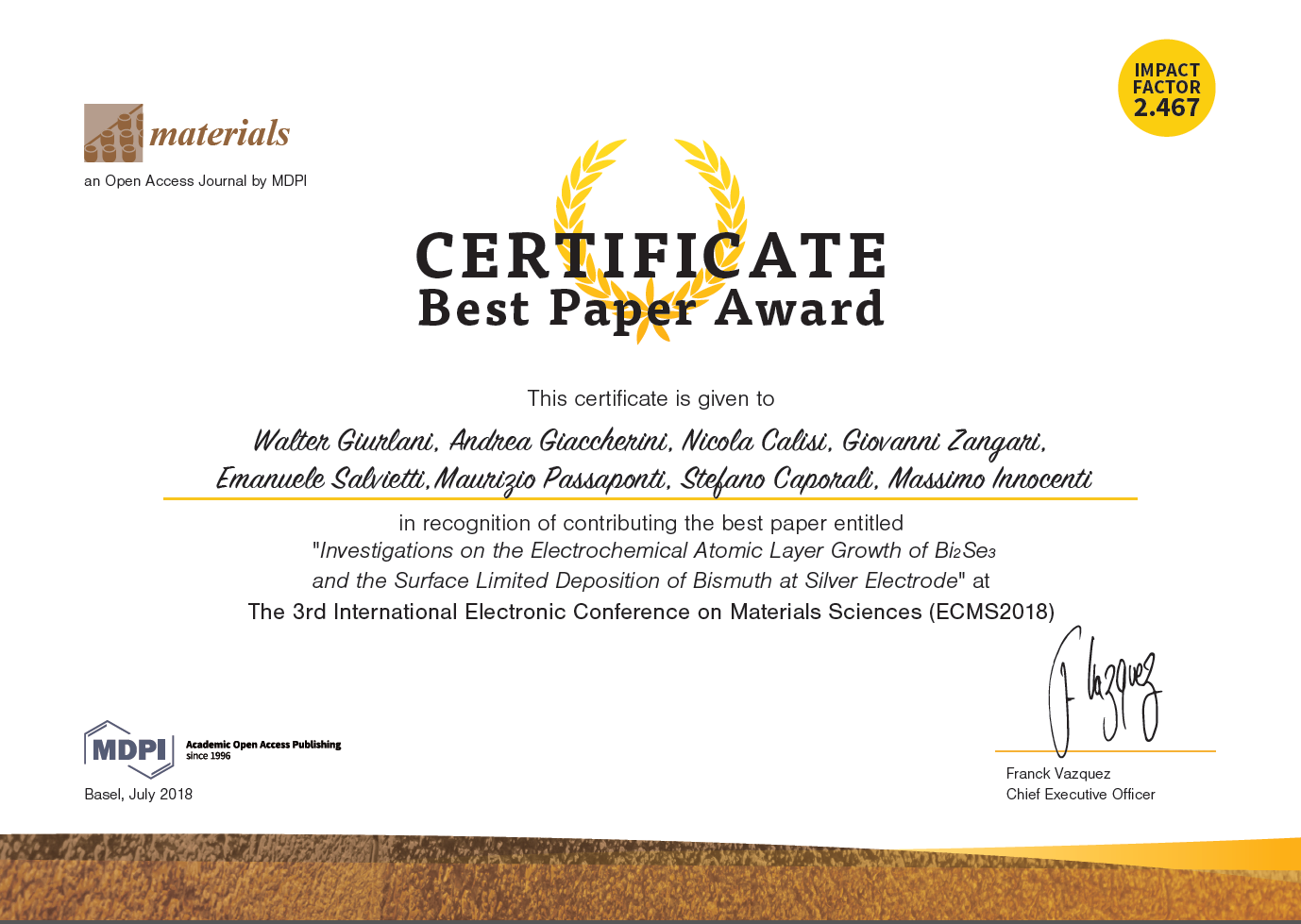
Conference Schedule
- Abstract Submission: 6 February 2018 16 March 2018
- Acceptance Notification: 27 February 2018 27 March 2018
- Full Paper Submission: 14 April 2018 24 April 2018
- Conference Open: 14–28 May 2018
Conference Organizers
Chair of the 3rd International Electronic Conference on Materials Science
Prof. Dr. Maryam Tabrizian
Professor of Biomedical Engineering,Associate Dean-Research and Graduate Studies-Faculty of Dentistry,
Fellow of Royal Society of Canada-Academy of Science,Guggenheim Fellow in Biomedical Sciences,
McGill University, Canada
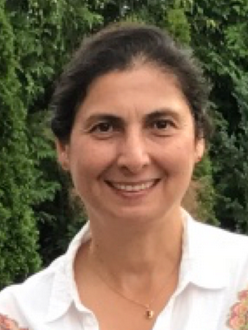
The University of Adelaide, Australia
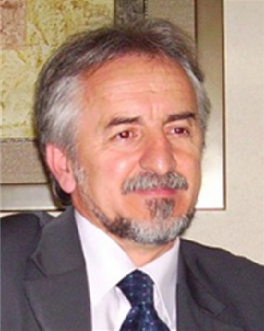
Conference Committee
Prof. Dr. Nicola Pugno, Universita degli Studi di Trento, Italy
Dr. Marco Salerno, IIT – Italian Institute of Technology, Italy
Prof. Dr. Rafael Luque, Universidad de Córdoba, Campus de Rabanales, Spain
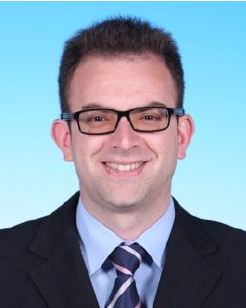
Dr. Vincenzo Baglio, CNR-ITAE Institute for Advanced Energy Technologies “N. Giordano”, Italy
Prof. Dr. Homayoun Hadavinia, Kingston University London, UK
Prof. Dr. Jonathan Phillips, Naval Postgraduate School, USA
Dr. Sofoklis Makridis, University of Patras, Greece
Prof. Oleg Lupan, Kiel University, Germany
Prof. Laichang Zhang, Edith Cowan University, Australia
Prof. Germán Francisco De La Fuente, Spanish National Research Council (CSIC), Spain
Best Paper Award
This year, as a sponsor, materials would like to award the best paper as elected by all the conference committee. The Award will consist of 500 Swiss Francs. We look forward to posting your contributions.
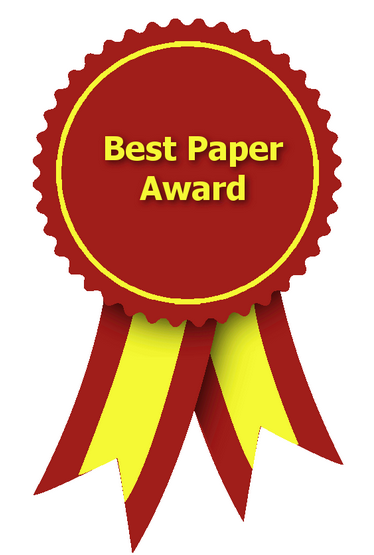
Criteria for Evaluation of Best Paper Award 2018:
Criteria
- Full paper must be submitted to ECMS 2018.
- Originality / Novelty of the paper.
- Significance of Content
- Scientific Soundness
- Interest to the readers
- English language and style
Evaluation
- Each Evaluation Committee member will give an assessment for each applicant in terms of the criteria outlined above.
- Total score for each presentation will be ranked, from highest to lowest.
- If two or more students get the same score, further evaluation will be carried out.
- All decisions made by the Evaluation Committee are final.
Publication
Free Media
1st International Online-Conference on Nanomaterials, Online, 22 March–5 April 2018
IOCN (https://sciforum.net/conference/IOCN%202018-1) is hosted on sciforum, the platform developed by MDPI for organising electronic conferences and discussion groups, and is supported by Section Chairs and a Scientific Committee comprised of highly reputable experts from academia. The conference will be completely free of charge—both to attend and for scholars to upload and present their latest work on the conference platform. There will also be the possibility to submit selected papers to the following journals: Nanomaterials (https://www.mdpi.com/journal/nanomaterials), with a 20% discount on the APCs; IOCN offers you the opportunity to participate in this international, scholarly conference without having the concern or expenditure of travel—all you need is your computer and access to the Internet. We would like to invite you to “attend” this conference and present your latest work.
Kind regards,
Your IOCN Organizing Team
iocn2018@mdpi.com
A. Materials Characterization
B. Nanotechnology in Material sciences and Engineering
Session Chair
Dr. - -, -
Show all accepted abstracts (1) Hide accepted abstracts (1)
List of Accepted Abstracts (1) Toggle list
C. Manufacturing Processes and Systems
D. Biomaterials
E. Fibers and Membranes
Session Chair
Dr. - -, -
Show all accepted abstracts (1) Hide accepted abstracts (1)
List of Accepted Abstracts (1) Toggle list
F. Optical, Electrical and Magnetic Materials
Session Chair
Dr. - -, -
Show all published submissions (7) Hide published submissions (7)
Submissions
List of Papers (7) Toggle list


























